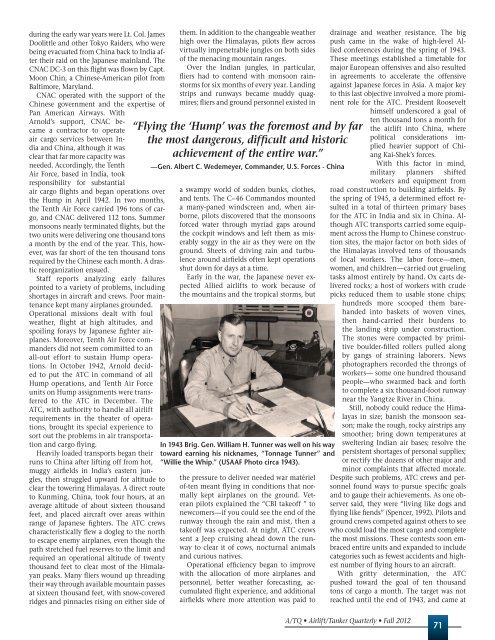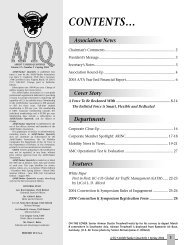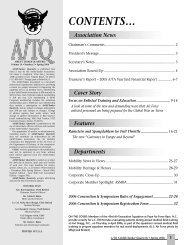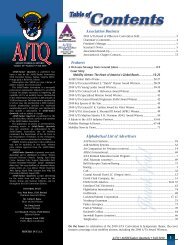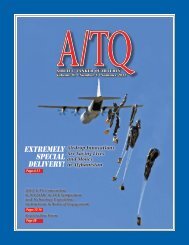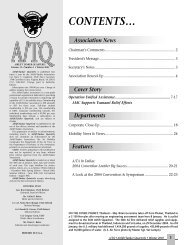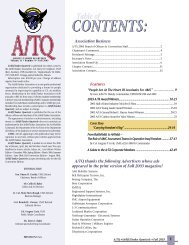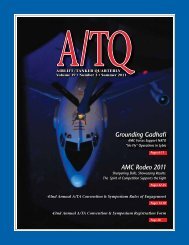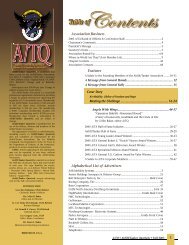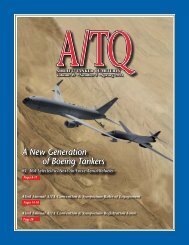A/TQ covers - Airlift/Tanker Association
A/TQ covers - Airlift/Tanker Association
A/TQ covers - Airlift/Tanker Association
You also want an ePaper? Increase the reach of your titles
YUMPU automatically turns print PDFs into web optimized ePapers that Google loves.
during the early war years were Lt. Col. James<br />
Doolittle and other Tokyo Raiders, who were<br />
being evacuated from China back to India after<br />
their raid on the Japanese mainland. The<br />
CNAC DC-3 on this flight was flown by Capt.<br />
Moon Chin, a Chinese-American pilot from<br />
Baltimore, Maryland.<br />
CNAC operated with the support of the<br />
Chinese government and the expertise of<br />
Pan American Airways. With<br />
Arnold’s support, CNAC became<br />
a contractor to operate<br />
air cargo services between India<br />
and China, although it was<br />
clear that far more capacity was<br />
needed. Accordingly, the Tenth<br />
Air Force, based in India, took<br />
responsibility for substantial<br />
air cargo flights and began operations over<br />
the Hump in April 1942. In two months,<br />
the Tenth Air Force carried 196 tons of cargo,<br />
and CNAC delivered 112 tons. Summer<br />
monsoons nearly terminated flights, but the<br />
two units were delivering one thousand tons<br />
a month by the end of the year. This, however,<br />
was far short of the ten thousand tons<br />
required by the Chinese each month. A drastic<br />
reorganization ensued.<br />
Staff reports analyzing early failures<br />
pointed to a variety of problems, including<br />
shortages in aircraft and crews. Poor maintenance<br />
kept many airplanes grounded.<br />
Operational missions dealt with foul<br />
weather, flight at high altitudes, and<br />
spoiling forays by Japanese fighter airplanes.<br />
Moreover, Tenth Air Force commanders<br />
did not seem committed to an<br />
all-out effort to sustain Hump operations.<br />
In October 1942, Arnold decided<br />
to put the ATC in command of all<br />
Hump operations, and Tenth Air Force<br />
units on Hump assignments were transferred<br />
to the ATC in December. The<br />
ATC, with authority to handle all airlift<br />
requirements in the theater of operations,<br />
brought its special experience to<br />
sort out the problems in air transportation<br />
and cargo flying.<br />
Heavily loaded transports began their<br />
runs to China after lifting off from hot,<br />
muggy airfields in India’s eastern jungles,<br />
then struggled upward for altitude to<br />
clear the towering Himalayas. A direct route<br />
to Kunming, China, took four hours, at an<br />
average altitude of about sixteen thousand<br />
feet, and placed aircraft over areas within<br />
range of Japanese fighters. The ATC crews<br />
characteristically flew a dogleg to the north<br />
to escape enemy airplanes, even though the<br />
path stretched fuel reserves to the limit and<br />
required an operational altitude of twenty<br />
thousand feet to clear most of the Himalayan<br />
peaks. Many fliers wound up threading<br />
their way through available mountain passes<br />
at sixteen thousand feet, with snow-covered<br />
ridges and pinnacles rising on either side of<br />
them. In addition to the changeable weather<br />
high over the Himalayas, pilots flew across<br />
virtually impenetrable jungles on both sides<br />
of the menacing mountain ranges.<br />
Over the Indian jungles, in particular,<br />
fliers had to contend with monsoon rainstorms<br />
for six months of every year. Landing<br />
strips and runways became muddy quagmires;<br />
fliers and ground personnel existed in<br />
“Flying the ‘Hump’ was the foremost and by far<br />
the most dangerous, difficult and historic<br />
achievement of the entire war.”<br />
—Gen. Albert C. Wedemeyer, Commander, U.S. Forces - China<br />
a swampy world of sodden bunks, clothes,<br />
and tents. The C–46 Commandos mounted<br />
a many-paned windscreen and, when airborne,<br />
pilots discovered that the monsoons<br />
forced water through myriad gaps around<br />
the cockpit windows and left them as miserably<br />
soggy in the air as they were on the<br />
ground. Sheets of driving rain and turbulence<br />
around airfields often kept operations<br />
shut down for days at a time.<br />
Early in the war, the Japanese never expected<br />
Allied airlifts to work because of<br />
the mountains and the tropical storms, but<br />
In 1943 Brig. Gen. William H. Tunner was well on his way<br />
toward earning his nicknames, “Tonnage Tunner” and<br />
“Willie the Whip.” (USAAF Photo circa 1943).<br />
the pressure to deliver needed war matériel<br />
of-ten meant flying in conditions that normally<br />
kept airplanes on the ground. Veteran<br />
pilots explained the “CBI takeoff ” to<br />
newcomers—if you could see the end of the<br />
runway through the rain and mist, then a<br />
takeoff was expected. At night, ATC crews<br />
sent a Jeep cruising ahead down the runway<br />
to clear it of cows, nocturnal animals<br />
and curious natives.<br />
Operational efficiency began to improve<br />
with the allocation of more airplanes and<br />
personnel, better weather forecasting, accumulated<br />
flight experience, and additional<br />
airfields where more attention was paid to<br />
drainage and weather resistance. The big<br />
push came in the wake of high-level Allied<br />
conferences during the spring of 1943.<br />
These meetings established a timetable for<br />
major European offensives and also resulted<br />
in agreements to accelerate the offensive<br />
against Japanese forces in Asia. A major key<br />
to this last objective involved a more prominent<br />
role for the ATC. President Roosevelt<br />
himself underscored a goal of<br />
ten thousand tons a month for<br />
the airlift into China, where<br />
political considerations implied<br />
heavier support of Chiang<br />
Kai-Shek’s forces.<br />
With this factor in mind,<br />
military planners shifted<br />
workers and equipment from<br />
road construction to building airfields. By<br />
the spring of 1945, a determined effort resulted<br />
in a total of thirteen primary bases<br />
for the ATC in India and six in China. Although<br />
ATC transports carried some equipment<br />
across the Hump to Chinese construction<br />
sites, the major factor on both sides of<br />
the Himalayas involved tens of thousands<br />
of local workers. The labor force—men,<br />
women, and children—carried out grueling<br />
tasks almost entirely by hand. Ox carts delivered<br />
rocks; a host of workers with crude<br />
picks reduced them to usable stone chips;<br />
hundreds more scooped them barehanded<br />
into baskets of woven vines,<br />
then hand-carried their burdens to<br />
the landing strip under construction.<br />
The stones were compacted by primitive<br />
boulder-filled rollers pulled along<br />
by gangs of straining laborers. News<br />
photographers recorded the throngs of<br />
workers— some one hundred thousand<br />
people—who swarmed back and forth<br />
to complete a six thousand-foot runway<br />
near the Yangtze River in China.<br />
Still, nobody could reduce the Himalayas<br />
in size; banish the monsoon season;<br />
make the rough, rocky airstrips any<br />
smoother; bring down temperatures at<br />
sweltering Indian air bases; resolve the<br />
persistent shortages of personal supplies;<br />
or rectify the dozens of other major and<br />
minor complaints that affected morale.<br />
Despite such problems, ATC crews and personnel<br />
found ways to pursue specific goals<br />
and to gauge their achievements. As one observer<br />
said, they were “living like dogs and<br />
flying like fiends” (Spencer, 1992). Pilots and<br />
ground crews competed against others to see<br />
who could load the most cargo and complete<br />
the most missions. These contests soon embraced<br />
entire units and expanded to include<br />
categories such as fewest accidents and highest<br />
number of flying hours to an aircraft.<br />
With gritty determination, the ATC<br />
pushed toward the goal of ten thousand<br />
tons of cargo a month. The target was not<br />
reached until the end of 1943, and came at<br />
A/<strong>TQ</strong> • <strong>Airlift</strong>/<strong>Tanker</strong> Quarterly • Fall 2012<br />
71


